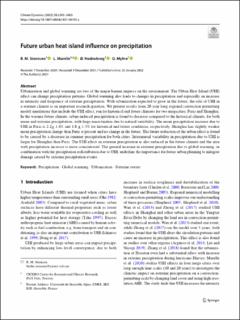| dc.contributor.author | Steensen, Birthe Marie Rødssæteren | |
| dc.contributor.author | Marelle-Sebrechts, Louis | |
| dc.contributor.author | Hodnebrog, Øivind | |
| dc.contributor.author | Myhre, Gunnar | |
| dc.date.accessioned | 2022-06-13T12:29:26Z | |
| dc.date.available | 2022-06-13T12:29:26Z | |
| dc.date.created | 2022-04-26T14:28:44Z | |
| dc.date.issued | 2022 | |
| dc.identifier.citation | Climate Dynamics. 2022, . | en_US |
| dc.identifier.issn | 0930-7575 | |
| dc.identifier.uri | https://hdl.handle.net/11250/2998541 | |
| dc.description.abstract | Urbanization and global warming are two of the major human impacts on the environment. The Urban Heat Island (UHI) effect can change precipitation patterns. Global warming also leads to changes in precipitation and especially an increase in intensity and frequency of extreme precipitation. With urbanization expected to grow in the future, the role of UHI in a warmer climate is an important research question. We present results from 20-year long regional convection-permitting model simulations that include the UHI effect, run for historical and future climates for two megacities, Paris and Shanghai. In the warmer future climate, urban-induced precipitation is found to decrease compared to the historical climate, for both mean and extreme precipitation, with large uncertainties due to natural variability. The mean precipitation increase due to UHI in Paris is 2.2± 1.4% and 1.8 ± 1.3% for historical and future conditions, respectively. Shanghai has slightly weaker mean precipitation change than Paris at present and no change in the future. The future reduction of the urban effect is found to be caused by a decrease in summer precipitation for both cities. Interannual variability in precipitation due to UHI is larger for Shanghai than Paris. The UHI effect on extreme precipitation is also reduced in the future climate and the area with precipitation increase is more concentrated. The general increase in extreme precipitation due to global warming, in combination with the precipitation redistribution due to UHI, underline the importance for future urban planning to mitigate damage caused by extreme precipitation events. | en_US |
| dc.language.iso | eng | en_US |
| dc.publisher | Springer Nature Ltd | en_US |
| dc.rights | Navngivelse 4.0 Internasjonal | * |
| dc.rights.uri | http://creativecommons.org/licenses/by/4.0/deed.no | * |
| dc.title | Future urban heat island influence on precipitation | en_US |
| dc.title.alternative | Future urban heat island influence on precipitation | en_US |
| dc.type | Journal article | en_US |
| dc.type | Peer reviewed | en_US |
| dc.description.version | publishedVersion | en_US |
| dc.source.pagenumber | 0 | en_US |
| dc.source.journal | Climate Dynamics | en_US |
| dc.identifier.doi | 10.1007/s00382-021-06105-z | |
| dc.identifier.cristin | 2019238 | |
| dc.relation.project | Norges forskningsråd: 250573 | en_US |
| cristin.ispublished | true | |
| cristin.fulltext | original | |
| cristin.qualitycode | 2 | |

